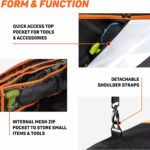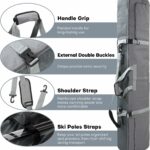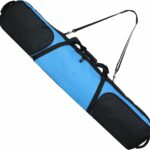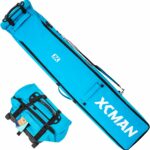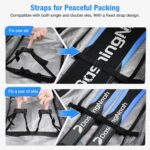Packing for a snowboarding trip can be a thrill, but the prospect of bringing your snowboard on a plane often inspires a sense of dread. Flying with a snowboard shouldn’t be nerve-wracking, as long as you follow some straightforward guidelines. This article will take you step by step through the process of safely and efficiently stowing your snowboard for air travel. Read on and you will be all set for your next adventure, with not a single scratch on your prized snowboard.
Understanding Airline Baggage Policies
When you’re planning to bring your snowboard on a plane, the first step is understanding the baggage policies of the different airlines.
Researching airlines with snowboard-friendly policies
Not all airlines are created equal when it comes to transporting sports equipment like snowboards. Some airlines count your snowboard bag as a regular checked bag, while others may consider it as oversized baggage and charge you extra. Make sure to choose an airline with a snowboard-friendly policy that accommodates your needs.
Reading through the airline’s sports equipment guidelines
Just as important, make sure to carefully read the airline’s sports equipment guidelines. These guidelines will cover everything from how to pack your snowboard to what size and weight limitations exist.
Checking size and weight limits for snowboards
Every airline has different size and weight limitations for checked bags, including sports equipment. Check these limitations before you pack your board to avoid incurring any additional fees or having to repack at the airport.
Packing the Snowboard Properly
Once you’ve got the low-down on your airline’s baggage policy, it’s time to get packing.
Purchasing a suitable snowboard bag
When it comes to transporting your snowboard, investing in a high-quality snowboard bag is a no brainer. Choose a bag that fits your board snugly, is durable and waterproof, and has enough additional room for related gear.
Securing the snowboard within the bag
After you’ve found your ideal bag, pack your snowboard securely within it. Make sure the board doesn’t move around in the bag when you do this – it should be tightly packed to prevent any damage during transit.
Including necessary snowboarding equipment and accessories
In addition to your snowboard, remember to pack any additional equipment and accessories that you’ll need. This usually includes goggles, gloves, and bindings.
Protecting Your Snowboard for Travel
A little extra protection goes a long way when you’re transporting a piece of gear that’s as important (and expensive!) as a snowboard.
Using padding or bubble wrap for additional protection
Even within a snowboard bag, there’s a chance your board could get damaged during transit. To ensure this doesn’t happen, consider using padding or bubble wrap as additional protection, especially around more fragile parts of your snowboard, such as the bindings.
Ensuring the bindings are faced-down
To further protect your board, pack it with the bindings faced down. Not only will this help to reduce the potential of damage during transport, but it will also make it easier to pack more efficiently.
Locking the bag if the it allows
If your snowboard bag has locks, make sure to use them. This is the simplest way to prevent unwanted access to your expensive gear.
Considering Snowboard Bags with Wheels
When it comes to picking the right bag for your snowboard, you have a lot of options.
Searching for high-quality bags with wheels
Bags with wheels provide a lot of advantages. While they may cost a bit more, the convenience they offer is unrivaled.
Understanding the benefits of wheeled bags
A wheeled snowboard bag can make your journey through the airport significantly easier, especially if you have other luggage to handle. Plus, they reduce the strain on your body as you’re moving from point A to point B.
Comparing wheeled and non-wheeled options
Although wheeled bags offer convenience, they may not be the best choice for everyone. Non-wheeled options might be lighter and less bulky, which could be a priority for you.
Checking the Snowboard at the Airport
Once you’ve packed your board and made your way to the airport, there are some essential steps to follow.
Approaching the airline’s check-in counter or drop-off area
With your snowboard packed and ready, head to the airline’s check-in counter or drop-off area. Here, airport staff will check your board’s size, weight, and packaging.
Paying any applicable fees
Depending on your airline’s baggage policy and the size and weight of your board, you may need to pay additional fees. Be prepared to handle these costs at the airport.
Retrieving the baggage claim slip
After your snowboard has been checked, make sure to gather any necessary paperwork such as a baggage claim slip. This will be key in retrieving your board once you land at your destination.
Carrying Other Snowboarding gears
In addition to your snowboard, you’ll likely have other snowboarding gear to transport.
Packing snowboard boots in carry-on
Snowboarding boots can often be bulky and difficult to pack. One option is to pack them in your carry-on luggage. This ensures they’re with you at all times and minimizes chances of loss or damage.
Carrying snowboarding apparel
Your snowboarding apparel is just as important as your gear. Make a packing checklist of every necessary item and consider carrying some with you in case your checked luggage arrives late.
Understanding rules about snowboarding helmets
There are differing rules about flying with snowboarding helmets. While some airlines allow you to carry it on, others may require it to be checked. Study the airline’s policy to avoid any confusion.
Knowing your rights as a passenger
Remember, as a passenger, you have certain rights when you bring your snowboard on a plane.
Understanding the airline’s responsibility for damage
Airlines are generally responsible for your checked baggage. If your snowboard gets damaged during transit, you’re entitled to compensation.
Knowing what to do when your snowboard is lost or delayed
Should your snowboard ends up lost or delayed, the airline should compensate you. Make sure you understand the details of this policy and the necessary steps to claim.
Knowing about airline compensation rules
If your snowboard is lost, damaged, or delayed, you should be familiar with the airline’s compensation rules. It will prove beneficial to be aware of these regulations when asserting your rights.
Going through security check
When you’re flying with a snowboard, security might seem daunting. But it doesn’t need to be if you are well-prepared and informed.
Presentation of the snowboard to security personnel
Issues at security are much less likely if you openly present your snowboard to security personnel. This demonstrates your willingness to cooperate with any additional checks.
Unpacking if required by the security protocol
Should security demand that you unpack your snowboard, comply without hesitation. Remember, they’re just doing their job to ensure everyone’s safety.
Reacting to potential security alerts linked to your snowboard
If your snowboard triggers a security alert, remain calm. Wait for instructions from security personnel and cooperate fully with any required checks.
Arriving at the Destination
Once you make it to your destination airport, you’re not quite done yet.
Finding the oversized luggage carousel
Snowboards, because of their size, often come out at the oversized luggage carousel. Make sure you know where it’s located so that you can retrieve your snowboard quickly.
Inspecting the snowboard for damage
Before leaving the airport, take the time to inspect your snowboard for any damage. If you do find something, make sure to inform the airline immediately.
Reporting any problems immediately
Should you encounter any problems with your snowboard, whether it’s damage, delay, or loss, report them to the airline immediately for quick resolution.
Considering To Rent a Snowboard Instead
If the thought of bringing your snowboard on a plane sounds like too much hassle, you might want to consider renting gear at your destination.
Comparing costs of checking snowboard versus renting
Remember to weigh the cost of checking your snowboard on your flight against the cost of renting gear when you arrive at your destination. In some cases, renting might be a more economical and hassle-free option.
Checking the availability of rental services at the destination
If you’re considering this option, make sure to check if there are reliable rental services available at your destination.
Understanding benefits and drawbacks of renting
While renting a snowboard can save you the hassle of traveling with one, it also means you’ll be using a different snowboard than you’re used to. Both options have their benefits and drawbacks, and the choice ultimately comes down to what you’re most comfortable with.
Knowing how to bring your snowboard on a plane can make your next snowboarding trip much smoother. Be sure to research and prepare adequately – and remember, the mountain is waiting!
- What Snowboard Bindings Should I Get? - January 23, 2024
- What Size Screws For Snowboard Bindings? - January 23, 2024
- How To Snowmobile On Water? - January 23, 2024

